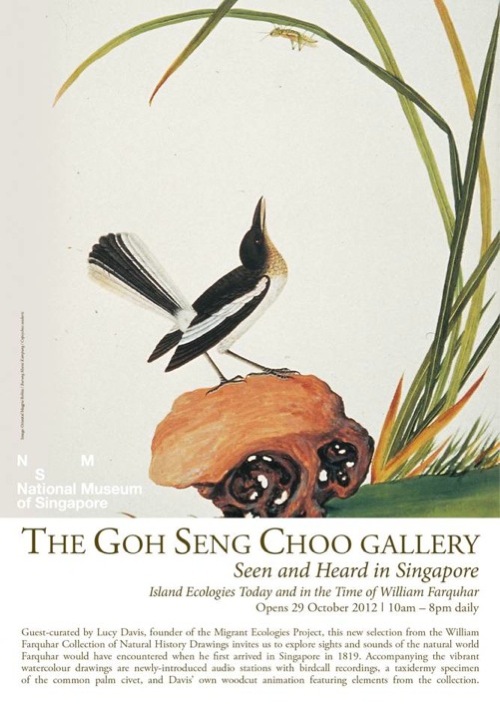The William Farquhar Collection of Natural History Drawings at the Goh Seng Choo Gallery, National Museum of Singapore’s sixth permanent gallery, has recently been rotated and is now open to the public!
This exhibition, “Seen & Heard in Singapore: Island Ecologies Today and in the Time of William Farquhar” featuring a selection of paintings commissioned by Singapore’s first Resident and Commandant, is guest curated by Assistant Prof Lucy Davis from School of Art, Design and Media, NTU. The exhibition is organised into six interesting themes which the public may relate to as this selection of beautiful watercolour drawings, each carefully chosen, aims to feature Singapore’s biodiversity today and at the same time highlight those that we have lost since Farquhar’s time. Special effort was also put in to include audio and visual aspects such as bird song recordings, a taxidermised common palm civet (on loan from the Raffles Museum of Biodiversity Research) and Together Again (Wood:Cut) – an animation video by guest curator Lucy. These definitely add an extra touch to the exhibition!

Themes of the exhibition awaiting your exploration:
- Birdsong in the Time of Farquhar – featuring birds present in William Farquhar’s time and today.
- No Animal is an Island – featuring the common palm civet and its relationship with several plant and animal species.
- Secrets of the Forest – featuring our charismatic yet little know local forest flora and fauna.
- Muddy Beginnings – featuring animals and plants denizens in our mangroves.
- The City of Palms – featuring a variety of palms in Singapore.
- Together Again (Wood:Cut) – An animation film by Lucy, featuring elements from the collection
We are also happy to mention that Lucy has kindly invited us to share about the biology and ecology of the common palm civet based on the research we have conducted on this last wild urban native carnivore in the past two years. A few of our civet photographs and those kindly contributed by Chan Kwok Wai were also selected to be featured. This documentation will accompany the taxidermised civet on display in the exhibition. Thank you Lucy for this excellent opportunity to raise awareness of the civet and to reach out to the public.

Photo by curator Daniel Tham (National Museum of Singapore facebook page)
Interested to find out more? Do drop by to learn more about Singapore’s amazing biodiversity, past and present, and at the same time, appreciate that we still have wildlife, even in our backyard!
Seen & Heard in Singapore: Island Ecologies Today and in the Time of William Farquhar
Date: Opens on 29 October 2012, Monday
Time: Open daily from 10am to 8pm
Admission: Free
Venue: The Goh Seng Choo Gallery, National Museum of Singapore, 93 Stamford Road, Singapore 178897 (nearest MRT station – Dhoby Ghaut/ Bras Basah; map)
Website/ Contact: www.nationalmuseum.sg / +65 6332 3659 / +65 6332 5642
Congratulations to Lucy and her team on putting this exhibition together so successfully! We will definitely make a trip down to view the exhibition!






